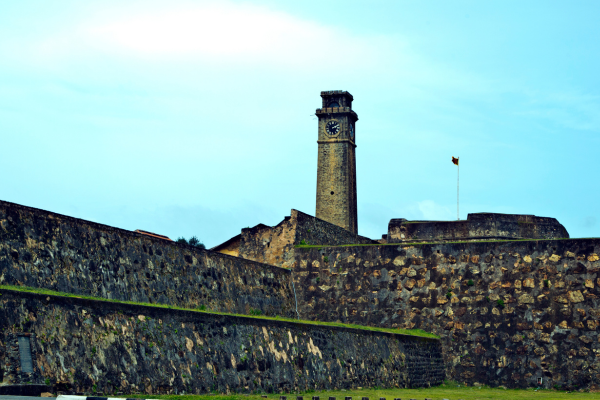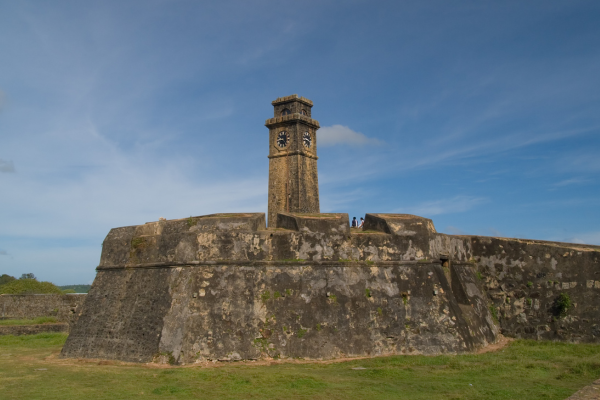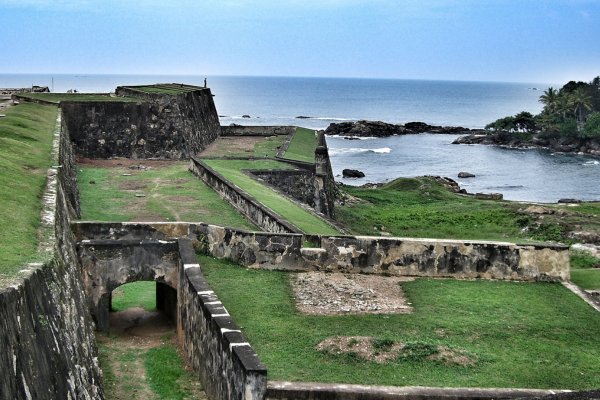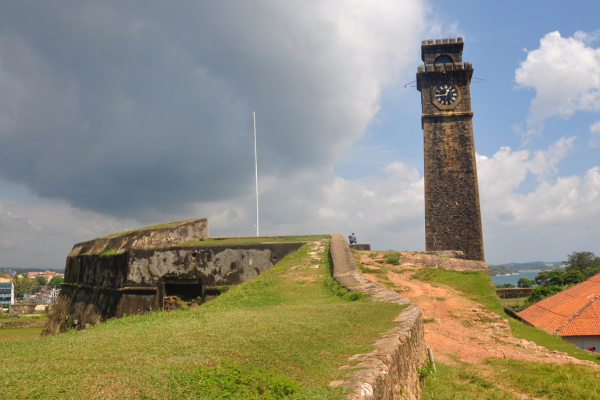Galle Fort History: A Journey Through Time – By Nadeeka – eLanka

Galle Fort, a UNESCO World Heritage Site, stands as one of Sri Lanka’s most iconic and historically significant landmarks. Situated on the southwestern coast of the island, this majestic fortress has withstood the test of time, bearing witness to centuries of colonial rule, trade, and cultural exchange. The history of Galle Fort is a tapestry woven with tales of conquest, architectural brilliance, and the rich cultural heritage of the region. This article delves deep into the history of Galle Fort, exploring its origins, architectural marvels, cultural significance, and the efforts to preserve its legacy for future generations.
The Origins of Galle Fort
The origins of Galle Fort can be traced back to the early 16th century when Portuguese explorers first set foot on the shores of Sri Lanka. Galle, then a thriving port city, quickly caught the attention of the Portuguese, who recognized its strategic importance as a hub for maritime trade. The Portuguese established a small fortification in Galle to protect their interests and secure their control over the region. This initial fort was relatively modest in size and construction, serving primarily as a defensive outpost and trading post.
The Portuguese presence in Galle marked the beginning of a new chapter in the history of the fort. Over the next few decades, they expanded and fortified the initial structure, transforming it into a formidable stronghold. The fort’s strategic location allowed the Portuguese to control the maritime routes along the Indian Ocean, facilitating trade with Europe, Asia, and Africa. The fort also served as a base for launching military expeditions and consolidating their colonial rule over the island.

The Dutch Era: Transformation and Expansion
The history of Galle Fort took a significant turn in the mid-17th century when the Dutch East India Company (VOC) ousted the Portuguese from Galle. The Dutch, known for their prowess in maritime trade and engineering, embarked on an ambitious project to transform Galle Fort into a state-of-the-art fortress. They brought with them advanced European architectural techniques and a vision to create a stronghold that could withstand both land and sea attacks.
Under Dutch rule, Galle Fort underwent extensive expansion and fortification. The fort’s layout was meticulously planned, incorporating the principles of Renaissance military architecture. The fortifications were designed to provide maximum defense against potential invaders, with thick walls, bastions, and strategically placed watchtowers. The walls were constructed using local materials such as coral and limestone, which not only provided durability but also blended harmoniously with the surrounding landscape.
One of the most remarkable features of the Dutch-era Galle Fort was its elaborate system of underground tunnels and passages. These tunnels were designed to facilitate the movement of troops and supplies within the fort, allowing for quick and efficient responses to any threats. The fort also boasted an impressive array of cannons and artillery, strategically positioned to cover all approaches to the fort.

The British Era: Adaptation and Preservation
In the early 19th century, the British East India Company wrested control of Sri Lanka from the Dutch, marking the beginning of the British colonial era. While the British did not make significant changes to the overall structure of Galle Fort, they did introduce some adaptations to suit their administrative and military needs. The fort continued to serve as a key military and administrative center, housing British troops and officials.
One of the notable changes made by the British was the construction of the iconic lighthouse at the southeastern tip of the fort. The Galle Lighthouse, built in the late 19th century, became an important navigational aid for ships entering and leaving the port. The British also introduced several administrative buildings, schools, and churches within the fort, further integrating it into the colonial infrastructure of the island.
Despite these adaptations, the British largely recognized the historical and architectural significance of Galle Fort and took measures to preserve its heritage. The fort’s walls, bastions, and other structures were meticulously maintained, ensuring that the fort retained its historical integrity. This commitment to preservation laid the foundation for Galle Fort’s eventual recognition as a UNESCO World Heritage Site.

Architectural Marvels of Galle Fort
Galle Fort is a treasure trove of architectural marvels that reflect the diverse influences and cultural exchanges that have shaped its history. The fort’s layout and design bear the unmistakable imprint of European military architecture, with its grid-like street plan, fortified walls, and bastions. However, the architectural features of Galle Fort also showcase a unique blend of European, South Asian, and Southeast Asian styles, resulting from centuries of trade and cultural interaction.
One of the most striking features of Galle Fort is its massive ramparts, which encircle the entire fort and provide panoramic views of the Indian Ocean. These ramparts, constructed using coral and limestone, are punctuated by bastions that once housed cannons and artillery. The bastions are named after Dutch monarchs and officials, reflecting the Dutch influence on the fort’s architecture. Visitors can walk along the ramparts, enjoying breathtaking views and gaining a sense of the fort’s formidable defenses.
Within the fort, the narrow, cobblestone streets are lined with colonial-era buildings that have been meticulously preserved. These buildings, with their distinctive Dutch and British architectural styles, serve as a testament to the fort’s colonial past. Many of these structures have been repurposed into museums, art galleries, boutique hotels, and cafes, adding to the fort’s charm and vibrancy.
One of the architectural gems of Galle Fort is the Dutch Reformed Church, also known as the Groote Kerk. Built in the late 17th century, this church is one of the oldest Protestant churches in Sri Lanka and is renowned for its elegant design and historical significance. The church’s interior features beautifully carved wooden pews, a pulpit, and tombstones embedded in the floor, providing a glimpse into the lives of the Dutch settlers who once worshipped there.
Another iconic structure within Galle Fort is the Old Dutch Hospital, a magnificent building that has been restored and transformed into a bustling shopping and dining precinct. This historic building, with its whitewashed walls and arched windows, is a prime example of Dutch colonial architecture. Today, it houses a variety of shops, restaurants, and cafes, offering visitors a chance to experience the fort’s history while enjoying modern amenities.
Cultural Significance and Legacy
Galle Fort is not only a testament to the island’s colonial past but also a vibrant cultural hub that continues to thrive in the present day. The fort’s rich history and diverse heritage have made it a melting pot of cultures, attracting visitors from around the world. Its streets are alive with the sights and sounds of daily life, as residents and tourists alike explore its many attractions.
One of the most significant cultural events held within Galle Fort is the annual Galle Literary Festival. This internationally renowned festival brings together writers, poets, and literary enthusiasts from across the globe to celebrate the written word. The festival features a diverse program of readings, discussions, workshops, and performances, all set against the backdrop of the historic fort. It has become a major highlight on Sri Lanka’s cultural calendar, drawing literary luminaries and visitors to Galle Fort each year.
Galle Fort is also home to a thriving arts and crafts scene, with numerous galleries and studios showcasing the work of local artists and artisans. Visitors can explore these galleries, admiring and purchasing a wide range of artworks, from traditional paintings and sculptures to contemporary pieces. The fort’s vibrant arts community adds to its cultural richness and provides a platform for local talent to shine.
In addition to its cultural significance, Galle Fort holds a special place in the hearts of its residents. Many families have lived within the fort for generations, contributing to its unique character and sense of community. The fort’s narrow streets, charming courtyards, and historic buildings create an intimate and welcoming atmosphere, fostering a strong sense of belonging among its inhabitants.
Preservation and Conservation Efforts
The recognition of Galle Fort as a UNESCO World Heritage Site in the late 20th century marked a turning point in the efforts to preserve and protect this historic landmark. The designation brought international attention to the fort’s historical and cultural significance, prompting concerted efforts to conserve its architectural heritage and ensure its sustainable development.
Several organizations, both governmental and non-governmental, have been involved in the preservation and conservation of Galle Fort. The Department of Archaeology of Sri Lanka, in collaboration with UNESCO, has undertaken numerous initiatives to restore and maintain the fort’s structures. These efforts include the restoration of the fort’s walls, bastions, and historic buildings, as well as the implementation of measures to protect the fort from environmental threats such as coastal erosion and climate change.
Community involvement has also played a crucial role in the preservation of Galle Fort. Local residents, business owners, and heritage enthusiasts have come together to form organizations and initiatives dedicated to safeguarding the fort’s heritage. These community-led efforts have included awareness campaigns, heritage walks, and cultural events aimed at promoting the fort’s history and encouraging responsible tourism.
One of the key challenges in preserving Galle Fort has been balancing the need for conservation with the demands of modern development. The fort’s popularity as a tourist destination has led to increased commercial activity and infrastructure development, which can pose risks to its historical integrity. To address these challenges, guidelines and regulations have been put in place to ensure that any new development within the fort is sensitive to its heritage and does not compromise its historical value.

Conclusion
Galle Fort stands as a magnificent testament to Sri Lanka’s rich and diverse history. From its origins as a Portuguese outpost to its transformation under Dutch rule and its adaptation during the British colonial era, the fort has played a central role in the island’s historical narrative. Its architectural marvels, cultural significance, and enduring legacy make it a cherished heritage site that continues to captivate and inspire.
The story of Galle Fort is one of resilience, adaptation, and preservation. It is a story that reflects the island’s ability to embrace its past while looking toward the future. As efforts to conserve and protect this historic landmark continue, Galle Fort remains a living monument to the enduring spirit of Sri Lanka’s cultural heritage. Visitors who walk its ancient streets and explore its storied walls are not only stepping into a bygone era but also becoming part of a legacy that transcends time.







